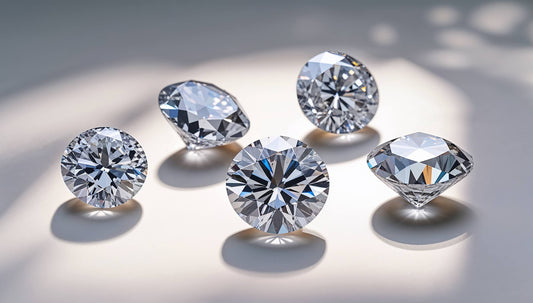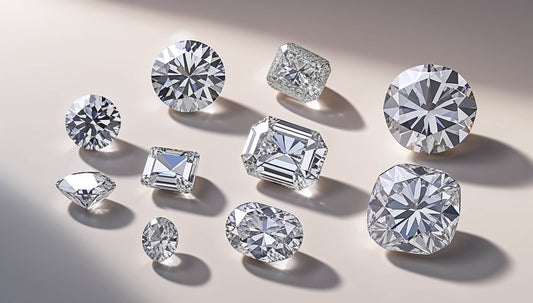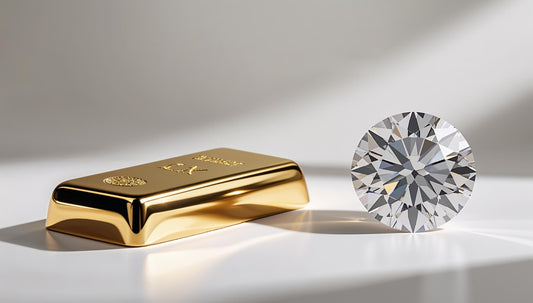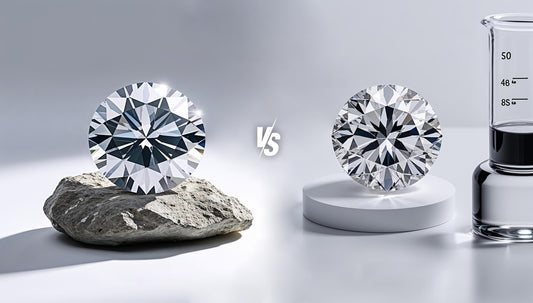Diamond Education
An engagement ring is more than a piece of jewelry—it’s a symbol of your commitment, values, and the love story you’re building together.
At Aralie, we believe choosing a diamond should feel personal, not overwhelming. That’s why we created this guide to the 7 most beloved diamond shapes—each with its own character, beauty, and meaning.
All lab-grown. All real. All unforgettable.
Round Brilliant Cut – The Forever Favorite
Why it’s iconic:
The Round Brilliant is the most classic and popular diamond shape of all time. With 58 precisely arranged facets, it delivers unmatched sparkle and perfect symmetry that have captivated generations.
Perfect for:
Couples who value tradition and timeless elegance
Those who want brilliance above all else
Solitaires, halos, and vintage-inspired settings
What it says:
You believe in forever. In grace. In a love that doesn’t follow trends—it defines them.
Oval Cut – The Modern Romantic
Why it’s trending:
The Oval Cut combines the fire of a Round Brilliant with an elongated shape that flatters the hand. It feels fresh, softly sophisticated, and a little unexpected.
Perfect for:
Minimalist settings with hidden halos
Romantic proposals that blend old and new traditions
Anyone who wants a balance of sparkle and modern shape
What it says:
You write your own story. You’re graceful, thoughtful, and unafraid to stand out—subtly.
Princess Cut – The Bold Geometric
Why it’s striking:
Square edges, crisp lines, and maximum fire make the Princess Cut a favorite among modern romantics. It’s clean, brilliant, and structured—perfect for expressing clarity and purpose.
Perfect for:
Sleek, contemporary engagement rings
Three-stone designs that showcase geometric symmetry
Statement rings that remain refined
What it says:
You’re confident, independent, and love with passion and focus.
Cushion Cut – The Soft Vintage
Why it’s loved:
Rounded corners and a pillow-like shape give the Cushion Cut its vintage allure. It combines deep sparkle with a sense of warmth and nostalgia.
Perfect for:
Halo settings or antique-inspired designs
Couples who appreciate history and romance
A softer take on timeless luxury
What it says:
You dream big, love deeply, and believe in romance that grows richer with time.
Emerald Cut – The Quiet Statement
Why it captivates:
The Emerald Cut doesn’t sparkle like others—it flashes. Its long step cuts create a hall-of-mirrors effect that feels architectural, sophisticated, and truly unique.
Perfect for:
Art Deco or minimalist settings
Those who value understated elegance over sparkle
Modern couples who appreciate originality
What it says:
You don’t follow—you lead, with quiet confidence and depth.
Radiant Cut – The Best of Both Worlds
Why it’s powerful:
The Radiant Cut combines the rectangular silhouette of the Emerald with the brilliance of a Round. It offers a bold, glamorous look with exceptional sparkle.
Perfect for:
Brides who embrace luxury without compromise
Custom, halo, or solitaire settings
Love stories full of passion and energy
What it says:
You light up every room and believe in doing things beautifully—or not at all.
Pear Cut – The Unforgettable One
Why it stands out:
The Pear Cut—also called a teardrop—merges round brilliance with a graceful tapered point. It’s delicate yet bold, with a sense of movement and individuality.
Perfect for:
Toi et Moi designs, solitaire settings, or bezels
Artistic souls who value self-expression
Couples who want a ring that feels unmistakably personal
What it says:
You’re bold, emotional, and live with your heart wide open.
What Makes Aralie Different?
At Aralie, we don’t just offer these shapes—we grow them. Every diamond is:
Ethically lab-grown with zero conflict
GIA/IGI certified for quality and authenticity
Cut and set by skilled artisans to tell your story
No middlemen. No guesswork. Just diamonds you can feel good about wearing forever.
Ready to Find the One?
Choosing a diamond shape is the first step toward a ring that feels like forever. Let your heart guide you—your story is already extraordinary.
Still Unsure? Here’s What We Tell Our Own Friends:
“Choose the shape you keep staring at.”
“Don’t overthink trends. Think about what you’ll love 20 years from now.”
“You can never go wrong with what feels personal.”
And remember: a diamond is just the beginning. The story it tells—the love it symbolizes—is what makes it priceless.
SHOP ENGAGEMENT RINGS
By Diamond Shape
Round
Oval
Pear
Cushion
Emerald
Radiant
Princess
Marquise
Asscher
Heart
E.Cushion
read more







